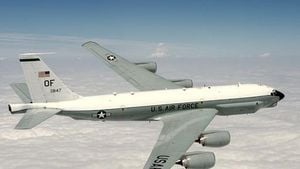In a dramatic escalation of the ongoing conflict, Ukraine launched one of its largest long-range drone barrages yet, targeting critical Russian military and energy infrastructure deep behind enemy lines. Overnight between October 5 and 6, 2025, Ukrainian forces claimed to have struck the Sverdlov ammunition plant in Russia’s Nizhny Novgorod region, a major oil terminal in occupied Crimea, and an ammunition depot belonging to Russia’s 18th Combined Arms Army. These attacks, confirmed by the Ukrainian General Staff and widely reported by international outlets such as AP, BBC, and DW, mark a significant intensification in Ukraine’s efforts to cripple Moscow’s war logistics and project power far beyond the front lines.
According to the Ukrainian military, the strike on the Sverdlov plant—located some 750 kilometers from the Ukrainian border—caused multiple explosions and a large fire. The facility is no ordinary target: it is described as one of Russia’s largest producers of explosives, supplying aviation and artillery ordnance, aerial bombs, and both anti-aircraft and anti-tank munitions to Russian forces. The General Staff stated, “The plant is one of the largest Russian producers of explosives. It is capable of equipping practically all types of ammunition.”
In tandem with the strike on the Sverdlov facility, Ukrainian drones also attacked the largest oil-processing terminal on the Crimean peninsula, which has been under Russian occupation since 2014. BBC Verify reported using heat map data and video verification techniques to confirm the overnight drone strikes, which ignited a blaze at the crucial energy hub. The Ukrainian General Staff further noted that a weapons depot of Russia’s 18th Combined Arms Army was also hit in the barrage.
Russian authorities acknowledged the scale of the Ukrainian onslaught, describing it as one of the largest drone attacks since the full-scale invasion began over three years ago. Officials claimed that air defenses shot down 251 Ukrainian drones across 14 Russian regions, as well as Crimea and areas surrounding the Black Sea and the Sea of Azov. Gleb Nikitin, governor of Nizhny Novgorod, stated that air defenses intercepted 20 drones targeting the industrial zone that houses the Sverdlov plant, insisting that no facilities were damaged. However, Ukrainian sources maintained that their strikes caused significant explosions and fires, with video evidence supporting their claims.
This latest wave of attacks is part of Ukraine’s broader strategy to disrupt Russian supply lines and pressure Moscow’s military logistics. As AP reported, Ukraine’s previous strikes on Russian refineries and oil facilities contributed to noticeable fuel shortages at gas stations across Russia in August 2025. These shortages have added a new layer of complexity to Russia’s war effort, as the country grapples with both battlefield attrition and logistical bottlenecks.
Ukraine’s ability to reach so deeply into Russian territory is the result of a rapid expansion in domestic weapons production, particularly in the field of drone technology. President Volodymyr Zelenskyy, speaking at a defense industry forum in Kyiv, revealed that Ukraine is now producing 40 Bohdana self-propelled artillery systems per month—up from just 10 units per month in April 2024. “Already at the front, more than 40% of the weapons used are weapons produced in Ukraine or with Ukraine,” Zelenskyy said. In 2024 alone, Ukraine produced and delivered 2.4 million shells to its front-line forces.
Looking ahead, Zelenskyy announced ambitious plans for Ukraine’s burgeoning defense industry. By the end of this year, he said, Ukraine aims to provide at least half of the weapons its troops require on the front line from domestic sources. Even more notably, Ukraine is poised to begin exporting surplus weapons to Europe, the United States, and the Middle East by the end of 2025. “The time has come to launch the export of our Ukrainian weapons—those types of weapons that we have in surplus, and therefore can be exported, so that there is funding for those types of weapons that are especially needed for defense,” Zelenskyy told the forum. He confirmed that agreements for such exports are already in place and that purchases could begin soon.
Ukraine’s push to develop and export advanced weaponry comes amid uncertainty over the future of Western military support. To compensate, Kyiv has invested heavily in domestic defense manufacturing, with a particular emphasis on cutting-edge drone technology. This not only strengthens Ukraine’s own war effort but also positions the country as a potential supplier to allied nations, using export revenues to acquire sophisticated systems—such as American-made Patriot air defense batteries—that it cannot yet produce domestically.
Meanwhile, the conflict’s human cost remains ever-present. On the same night as the drone attacks, a Russian strike set the roof of a perinatal center ablaze in the northeastern Ukrainian city of Sumy. According to presidential chief of staff Andriy Yermak, all 11 infants, 35 patients, and 120 staff members inside the facility managed to reach a shelter safely, avoiding casualties. In Kherson, however, a 69-year-old woman was killed and 12 others were injured, including two minors, in ongoing Russian assaults. The International Atomic Energy Agency (IAEA) also reported hearing shelling near the Zaporizhzhia nuclear power plant, raising fresh concerns about nuclear safety as the war grinds on.
International reactions to the strikes have been swift. German Chancellor Friedrich Merz accused Russian President Vladimir Putin of waging a "hybrid war" not only against Ukraine but also against the wider European community, citing Moscow’s campaign of military, information, and economic pressure. Merz emphasized that supporting Ukraine is essential for defending Europe’s open, liberal societies, and he called for closing all loopholes in sanctions that allow Russia to acquire foreign-made components for its weapons. Zelenskyy echoed this sentiment, noting that Russian weapons used in the October 5 attacks contained over 100,000 parts sourced from companies in the United States, China, Taiwan, and several European countries.
As Ukraine’s drone attacks grow in frequency and sophistication, the war appears to be entering a new phase—one defined by technological innovation, deep strikes, and the race to outmaneuver each other’s supply chains. With both sides digging in and no end in sight, the world watches closely as Ukraine leverages its homegrown ingenuity to challenge Russia’s military might far beyond the front lines.
For now, the conflict continues to evolve, with each new strike reshaping the battlefield and the broader geopolitical landscape in ways that few could have predicted at the outset of the war.





